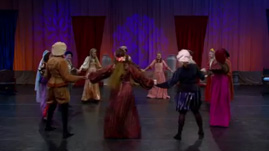Teachers' Domain - Digital Media for the Classroom and Professional Development
User: Preview



Kentucky students perform the Maltese Bransle (pronounced brahwl), a country dance that was popular in the royal courts of France and England during the Renaissance. The segment was recorded by KET in partnership with the Kentucky Arts Council and Kentucky Shakespeare. Kentucky Shakespeare also provided the costumes worn by the dancers.
This resource is part of the Arts in the Renaissance collection.
In the expanding world of the Renaissance, the church became less powerful, and social and artistic dance grew in importance. Members of the monarchy underscored their power through lavish social events that included dancing. The Renaissance court dance was an important time to see and be seen, an opportunity to learn the news of the day, and a place to make important social connections.
Guests at a Renaissance court dance wore elaborately patterned brocades and velvets. Dancers performed between each course of the dinner, and themes linked menus, costumes, and dances.
The Bransle, or Branle, is an old French country dance that became popular in the royal courts of France and England during the Renaissance. Frequently, the Court would travel to the country to learn the dances of the peasants. These dances were considered more fun than the more formal dances such as the Pavane because the country dances were not subject to the same strict rules that applied to proper court dances. The Bransle is a very social dance that reflects the strong sense of community that existed in the country.
There are many variations of the Bransle found throughout the world. The Maltese Bransle performed in the video segment shows influence of Middle Eastern belly dancing. Originally, a large chain of dancers stepping side to side performed the dance with large sideways steps to the left followed by an equal number of smaller steps to the right. The steps are very simple, with participants forming a circle stepping side to side and stepping forward to the center and back again to reestablish the large circle. The steps are repeated over and over as the music gets faster and faster. It became the goal of the dancers to be the last one standing as the music progressively grew faster. The festive nature of the dance penetrated social barriers and brought people together, thus its popularity has survived throughout history.
 Loading Standards
Loading Standards